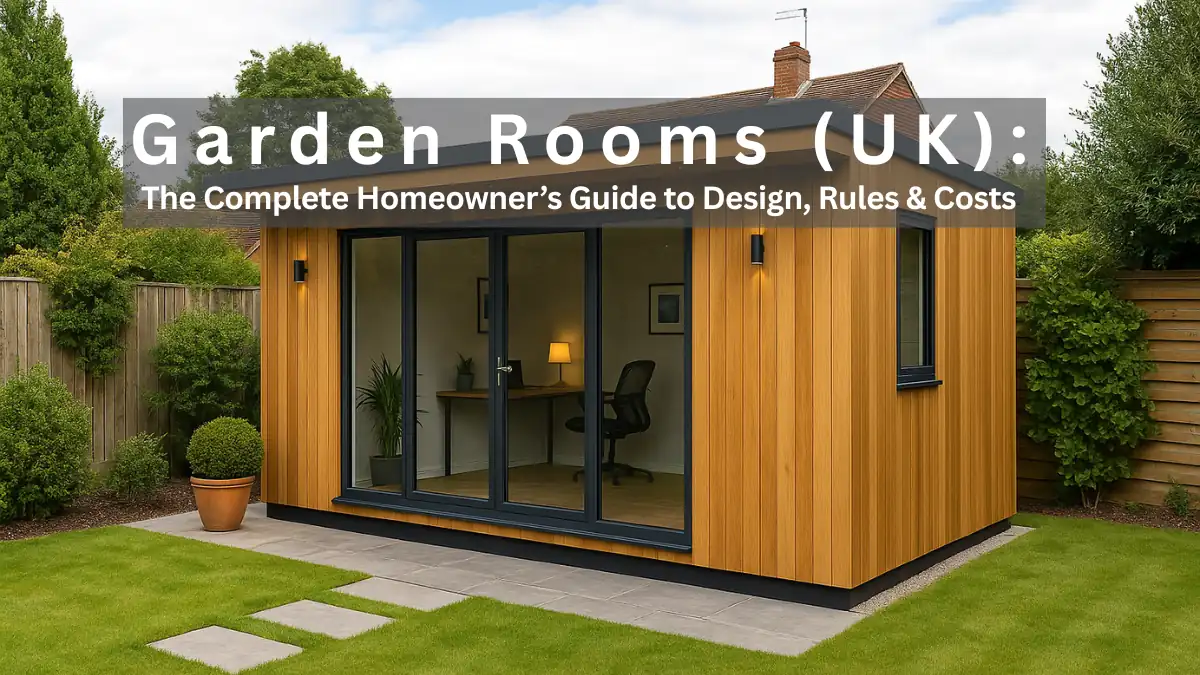Share this post:
Thinking about adding a Garden Room?
We can prepare compliant plans and check your design meets Permitted Development and Building Regulations before you build.
Garden Rooms have become one of the most popular home upgrades across the UK — offering extra living, office, or leisure space without needing to move house. But before you order a prefabricated unit or hire a builder, it’s important to understand the planning rules, design limits, and when Building Regulations apply. This guide walks you through everything — from design ideas and insulation to permissions, costs, and council quirks — so you can create your perfect garden retreat with confidence.
1. What Is a Garden Room?
A garden room is a detached structure built within your garden — typically separate from the main house — used for work, leisure, fitness, or living space. Unlike a simple shed, a garden room is insulated, powered, and often built to near-habitable standards.
Note: The term “garden room” covers many variations — from small timber studios to large, fully insulated annexes with plumbing and heating.
Whether you’re creating a quiet workspace or a family hangout, garden rooms are classed as outbuildings under UK planning law. That means the rules depend on size, height, and proximity to boundaries — and not all builds need planning permission.
2. Planning Permission Rules
Most garden rooms in England fall under Permitted Development (PD) rights — meaning you can build without a full planning application if certain limits are met. However, there are clear conditions:
- It must be single-storey.
- Max height 2.5m if within 2m of a boundary.
- Max overall height 4m (dual-pitched roof) or 3m (flat roof).
- Cannot take up more than 50% of your garden’s land area.
- Use must be “incidental to the enjoyment of the dwelling” (not self-contained living).
Important: Garden rooms used as bedrooms, kitchens, or main living areas will require planning permission and Building Regulations approval, as they become habitable spaces.
Homes in conservation areas, listed buildings, or Areas of Outstanding Natural Beauty (AONB) have tighter controls — always check with your local council before starting.
To learn more about general planning permission rules, see our complete guide:
Planning Permission (UK): The Complete Homeowner’s Guide
3. Garden Rooms & Permitted Development
Under PD rights, most outbuildings can be built without full planning permission. However, PD does not apply to flats, maisonettes, or properties with previous extensions that already used up PD limits.
Tip: You can confirm whether your idea qualifies for PD through a Lawful Development Certificate. This provides written council confirmation that your project is compliant — invaluable when selling or refinancing your home.
For more insight on when Permitted Development applies, explore:
Do I Need Planning Permission?
4. Common Uses & Design Ideas
Garden rooms can be tailored to almost any purpose — here are the most popular UK uses:
- Home offices or studios
- Garden gyms or wellness rooms
- Hobby workshops or music studios
- Family leisure spaces or playrooms
- Annex-style guest accommodation (requires consent)
Note: You can also add plumbing, heating, and broadband — but once it becomes a self-contained unit, you’ll need planning permission and Building Regulations.
To see how this differs from other home projects, visit:
House Extensions: Complete UK Guide
5. Garden Room Costs Snapshot (2025)
- Basic insulated garden office: £10,000–£20,000
- Mid-range composite room (4x3m): £20,000–£35,000
- Luxury annex with plumbing/heating: £40,000–£80,000+
Costs vary based on materials, access, insulation, and services (electricity, water, drainage).
Need help budgeting your project? Explore our full guide on:
Extension Costs (UK Homeowner’s Guide)
Not sure if your idea fits Permitted Development?
We’ll check your project against PD rules and let you know if you need a full planning application.
6. Building Regulations & Compliance
Even if your garden room doesn’t need planning permission, it may still need to comply with Building Regulations — especially if it includes electricity, plumbing, or is used as sleeping accommodation.
- Rooms under 15m² — usually exempt if not used for sleeping.
- Rooms 15–30m² — exempt if at least 1m from boundaries and built of non-combustible material.
- Over 30m² — always requires Building Regulations approval.
Warning: If you wire electrics or add plumbing without sign-off, your project may fail resale checks or invalidate insurance. Always use certified tradespeople and request compliance certificates.
To learn more about inspections and certificates, see:
Building Control Inspections: What to Expect
7. Step-by-Step: How to Build a Garden Room
| Step | Action | Details |
|---|---|---|
| 1 | Design & Size | Choose layout, dimensions, roof type, and finishes. |
| 2 | Check PD Limits | Confirm height and boundary distances. |
| 3 | Apply for LDC (optional) | Apply to your council to confirm legality. |
| 4 | Prepare Base | Use a concrete slab or screw pile foundations. |
| 5 | Build Structure | Timber frame, SIPs, or steel depending on supplier. |
| 6 | Install Services | Add electrics, lighting, and optional plumbing. |
| 7 | Sign-Off | Obtain any necessary Building Control certificates. |
8. Common Pitfalls & Gotchas
Gotcha: Many garden room companies advertise “no planning permission required” — but that only applies to basic setups. If you add plumbing, use it for business clients, or it’s over 2.5m near a fence, you’ll likely need permission.
Before committing to a build, it’s smart to read:
Building Over Sewers – Rules & Permissions Explained
9. FAQs
Do garden rooms need planning permission?
Not always — most are allowed under Permitted Development, but larger, higher, or habitable builds do require permission.
Do garden rooms add value?
Yes — a well-built, insulated garden room can increase property value by 5–15%, depending on design and location.
Can you live in a garden room?
Only if it has full planning permission and meets Building Regulations for habitable accommodation.
Do garden rooms need Building Regulations approval?
Yes, if over 30m², or if it includes sleeping, plumbing, or fixed heating.
Are garden rooms warm in winter?
Modern insulated garden rooms are designed for year-round use — typically using SIPs panels, double glazing, and electric panel heating.
How long do garden rooms last?
With proper maintenance, 25–50 years or more depending on materials and exposure.
Ready to move your project forward?
Plans Made Easy can prepare compliant plans, manage submissions, and guide you from idea to approval.
Next Steps & Useful Guides
- Planning Permission for a Garage Conversion
- Building Regulations: Complete Homeowner’s Guide
- Extension Costs (UK Guide)
- Do I Need Planning Permission?
- Building Control – What It Is and How to Pass
- Loft Conversions: UK Costs, PD Rules & Council Quirks
- House Extensions – Complete UK Guide
External Resources

Performance Verified ✅
This page meets PME Optimisation Standards — achieving 95+ Desktop and 85+ Mobile PageSpeed benchmarks. Verified on


